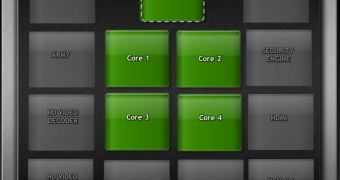NVIDIA's latest mobile platform is known by multiple names, such as Kal-El, Tegra 3 and the VSMP architecture, but it now has an official trademark.
In its latest blog post, the Santa Clara, California-based GPU maker has announced the name it will, from now on, use to refer to the architecture of the Tegra 3.
While the chip itself will continue to bear its current monikers, the layout of its insides has been given its own trademark.
Henceforth, it shall be known far and wide that the third-generation mobile platform is powered by the 4-PLUS-1 quad-core architecture.
This is arguably the most straightforward label NVIDIA could have ever stuck to a chip that has four ARM cores and a fifth “ninja” core that is a sort of replacement for all the rest.
The four primary cores handle most things that a user does on a tablet, provided the workload is above a certain threshold.
In other words, they work fully while users are playing games or watching high-quality video, or even during wireless communications.
The fifth core is a low-power chip that takes over for all the others when less demanding tasks are initiated, like processing mail. Likewise, only this “ninja” core works when the slate is in standby mode.
Basically, the fifth core comes into play when the Tegra 3 goes into power saving mode, in order to preserve battery life.
“Today, we’re officially calling it the 4-PLUS-1 quad-core architecture and trademarking the name,” NVIDIA's Michael Rayfield says on the company blog.
“What this revolutionary architecture does is simple: It provides both exceptional processing power and great battery life, It does this by using four powerful CPU cores to handle demanding tasks, such as gaming, and a fifth low-power, battery-saver core to manage less strenuous tasks – like processing e-mail or operating in standby mode.”
The 4-PLUS-1 trademark should start showing up on product packages.

 14 DAY TRIAL //
14 DAY TRIAL //